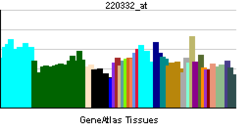- CLDN16
-
Claudin 16 Identifiers Symbols CLDN16; HOMG3; PCLN1 External IDs OMIM: 603959 MGI: 2148742 HomoloGene: 4799 GeneCards: CLDN16 Gene Gene Ontology Molecular function • structural molecule activity
• magnesium ion transmembrane transporter activity
• identical protein bindingCellular component • plasma membrane
• tight junction
• integral to membrane
• cell junctionBiological process • ion transport
• cellular metal ion homeostasis
• excretion
• magnesium ion transport
• calcium-independent cell-cell adhesionSources: Amigo / QuickGO RNA expression pattern 
More reference expression data Orthologs Species Human Mouse Entrez 10686 114141 Ensembl ENSG00000113946 ENSMUSG00000038148 UniProt Q9Y5I7 Q14BW2 RefSeq (mRNA) NM_006580 NM_053241.5 RefSeq (protein) NP_006571 NP_444471.1 Location (UCSC) Chr 3:
190.04 – 190.13 MbChr 16:
26.46 – 26.48 MbPubMed search [1] [2] Claudin-16 is a protein that in humans is encoded by the CLDN16 gene.[1][2] It belongs to the group of claudins.
Tight junctions represent one mode of cell-to-cell adhesion in epithelial or endothelial cell sheets, forming continuous seals around cells and serving as a physical barrier to prevent solutes and water from passing freely through the paracellular space. These junctions are composed of sets of continuous networking strands in the outwardly facing cytoplasmic leaflet, with complementary grooves in the inwardly facing extracytoplasmic leaflet. The protein encoded by this gene, a member of the claudin family, is an integral membrane protein and a component of tight junction strands. It is found primarily in the kidneys, specifically in the thick ascending limb of Henle, where it acts as either an intercellular pore or ion concentration sensor to regulate the paracellular resorption of magnesium ions. Defects in this gene are a cause of primary hypomagnesemia, which is characterized by massive renal magnesium wasting with hypomagnesemia and hypercalciuria, resulting in nephrocalcinosis and renal failure.[2]
References
- ^ Simon DB, Lu Y, Choate KA, Velazquez H, Al-Sabban E, Praga M, Casari G, Bettinelli A, Colussi G, Rodriguez-Soriano J, McCredie D, Milford D, Sanjad S, Lifton RP (Jul 1999). "Paracellin-1, a renal tight junction protein required for paracellular Mg2+ resorption". Science 285 (5424): 103–6. doi:10.1126/science.285.5424.103. PMID 10390358.
- ^ a b "Entrez Gene: CLDN16 claudin 16". http://www.ncbi.nlm.nih.gov/sites/entrez?Db=gene&Cmd=ShowDetailView&TermToSearch=10686.
Further reading
- Kniesel U, Wolburg H (2000). "Tight junctions of the blood-brain barrier". Cell. Mol. Neurobiol. 20 (1): 57–76. doi:10.1023/A:1006995910836. PMID 10690502.
- Heiskala M, Peterson PA, Yang Y (2001). "The roles of claudin superfamily proteins in paracellular transport". Traffic 2 (2): 93–8. doi:10.1034/j.1600-0854.2001.020203.x. PMID 11247307.
- Tsukita S, Furuse M, Itoh M (2001). "Multifunctional strands in tight junctions". Nat. Rev. Mol. Cell Biol. 2 (4): 285–93. doi:10.1038/35067088. PMID 11283726.
- Tsukita S, Furuse M (2003). "Claudin-based barrier in simple and stratified cellular sheets". Curr. Opin. Cell Biol. 14 (5): 531–6. doi:10.1016/S0955-0674(02)00362-9. PMID 12231346.
- González-Mariscal L, Betanzos A, Nava P, Jaramillo BE (2003). "Tight junction proteins". Prog. Biophys. Mol. Biol. 81 (1): 1–44. doi:10.1016/S0079-6107(02)00037-8. PMID 12475568.
- Manz F, Schärer K, Janka P, Lombeck J (1978). "Renal magnesium wasting, incomplete tubular acidosis, hypercalciuria and nephrocalcinosis in siblings". Eur. J. Pediatr. 128 (2): 67–79. doi:10.1007/BF00496992. PMID 668721.
- Weber S, Hoffmann K, Jeck N et al. (2000). "Familial hypomagnesaemia with hypercalciuria and nephrocalcinosis maps to chromosome 3q27 and is associated with mutations in the PCLN-1 gene". Eur. J. Hum. Genet. 8 (6): 414–22. doi:10.1038/sj.ejhg.5200475. PMID 10878661.
- Weber S, Schneider L, Peters M et al. (2001). "Novel paracellin-1 mutations in 25 families with familial hypomagnesemia with hypercalciuria and nephrocalcinosis". J. Am. Soc. Nephrol. 12 (9): 1872–81. PMID 11518780.
- Strausberg RL, Feingold EA, Grouse LH et al. (2003). "Generation and initial analysis of more than 15,000 full-length human and mouse cDNA sequences". Proc. Natl. Acad. Sci. U.S.A. 99 (26): 16899–903. doi:10.1073/pnas.242603899. PMC 139241. PMID 12477932. http://www.pubmedcentral.nih.gov/articlerender.fcgi?tool=pmcentrez&artid=139241.
- Müller D, Kausalya PJ, Claverie-Martin F et al. (2004). "A Novel Claudin 16 Mutation Associated with Childhood Hypercalciuria Abolishes Binding to ZO-1 and Results in Lysosomal Mistargeting". Am. J. Hum. Genet. 73 (6): 1293–301. doi:10.1086/380418. PMC 1180395. PMID 14628289. http://www.pubmedcentral.nih.gov/articlerender.fcgi?tool=pmcentrez&artid=1180395.
- Gerhard DS, Wagner L, Feingold EA et al. (2004). "The Status, Quality, and Expansion of the NIH Full-Length cDNA Project: The Mammalian Gene Collection (MGC)". Genome Res. 14 (10B): 2121–7. doi:10.1101/gr.2596504. PMC 528928. PMID 15489334. http://www.pubmedcentral.nih.gov/articlerender.fcgi?tool=pmcentrez&artid=528928.
- Hou J, Paul DL, Goodenough DA (2005). "Paracellin-1 and the modulation of ion selectivity of tight junctions". J. Cell. Sci. 118 (Pt 21): 5109–18. doi:10.1242/jcs.02631. PMID 16234325.
- Kausalya PJ, Amasheh S, Günzel D et al. (2006). "Disease-associated mutations affect intracellular traffic and paracellular Mg2+ transport function of Claudin-16". J. Clin. Invest. 116 (4): 878–91. doi:10.1172/JCI26323. PMC 1395478. PMID 16528408. http://www.pubmedcentral.nih.gov/articlerender.fcgi?tool=pmcentrez&artid=1395478.
- Türkmen M, Kasap B, Soylu A et al. (2007). "Paracellin-1 gene mutation with multiple congenital abnormalities". Pediatr. Nephrol. 21 (11): 1776–8. doi:10.1007/s00467-006-0247-7. PMID 16924549.
Categories:- Human proteins
- Chromosome 3 gene stubs
Wikimedia Foundation. 2010.
